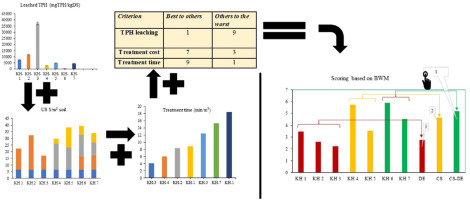当前位置:
X-MOL 学术
›
Environ. Pollut.
›
论文详情
Our official English website, www.x-mol.net, welcomes your
feedback! (Note: you will need to create a separate account there.)
Selecting the best stabilization/solidification method for the treatment of oil-contaminated soils using simple and applied best-worst multi-criteria decision-making method.
Environmental Pollution ( IF 7.6 ) Pub Date : 2020-04-03 , DOI: 10.1016/j.envpol.2020.114447 Rahele Kujlu 1 , Mehrdad Moslemzadeh 2 , Somayeh Rahimi 1 , Ehsan Aghayani 1 , Farshid Ghanbari 1 , Mostafa Mahdavianpour 1
Environmental Pollution ( IF 7.6 ) Pub Date : 2020-04-03 , DOI: 10.1016/j.envpol.2020.114447 Rahele Kujlu 1 , Mehrdad Moslemzadeh 2 , Somayeh Rahimi 1 , Ehsan Aghayani 1 , Farshid Ghanbari 1 , Mostafa Mahdavianpour 1
Affiliation

|
Oil-contaminated soils resulted from drilling activities can cause significant damages to the environment, especially for living organisms. Treatment and management of these soils are the necessity for environmental protection. The present study investigates the field study of seven oil-contaminated soils treated by different stabilization/solidification (S/S) methods, and the selection of the best treated site and treatment method. In this study, first, the ratios of consumed binders to the contaminated soils (w/w) and the treatment times for each unit of treated soils were evaluated. The ratios of consumed binders to the contaminated soils were between 6 and 10% and the treatment times for each unit of treated soils were between 4.1 and 18.5 min/m3. Physicochemical characteristics of treated soils were also determined. Although S/S methods didn't change the water content of treated soils, they increased the porosity of soils. Unexpectedly, the cement-based S/S methods didn't increase the pH of the treated soils. The highest and the lowest leaching of petroleum hydrocarbons was belonging to S/S using diatomaceous earth (DE) and the combination of Portland cement, sodium silicate and DE (CS-DE), respectively. The best acid neutralization capacity was obtained for soils treated using the combination of Portland cement and sodium silicate (CS). Based on the best-worst multi-criteria decision-making method (BWM-MCDM), the soils treated using CS-DE was select as the best. The BWM-MCDM can be used as an effective tool for the selection of the best alternative in all areas of environmental decontamination.
中文翻译:

使用简单且应用最糟糕的多准则决策方法,选择用于处理油污土壤的最佳稳定/固化方法。
钻井活动造成的石油污染土壤会严重破坏环境,特别是对生物体。这些土壤的处理和管理是环境保护的必要条件。本研究调查了用不同的稳定/固化(S / S)方法处理的七种油污土壤的现场研究,以及最佳处理地点和处理方法的选择。在这项研究中,首先,评估了每单位处理土壤中所消耗的粘合剂与污染土壤的比率(w / w)以及处理时间。消耗的粘合剂与受污染土壤的比率为6%至10%,每单位处理过的土壤的处理时间为4.1至18.5 min / m3。还确定了处理过的土壤的理化特性。尽管S / S方法没有改变处理过的土壤的水分含量,但它们增加了土壤的孔隙度。出乎意料的是,基于水泥的S / S方法并未增加处理土壤的pH值。使用硅藻土(DE)以及硅酸盐水泥,硅酸钠和DE(CS-DE)的组合分别对石油烃的最高和最低浸出属于S / S。对于使用波特兰水泥和硅酸钠(CS)组合处理的土壤,酸中和能力最佳。基于最差多准则决策方法(BWM-MCDM),选择使用CS-DE处理的土壤为最佳。BWM-MCDM可以用作在所有环境净化领域中选择最佳替代品的有效工具。他们增加了土壤的孔隙度。出乎意料的是,基于水泥的S / S方法并未增加处理土壤的pH值。使用硅藻土(DE)以及硅酸盐水泥,硅酸钠和DE(CS-DE)的组合分别对石油烃的最高和最低浸出属于S / S。对于使用波特兰水泥和硅酸钠(CS)组合处理的土壤,酸中和能力最佳。基于最差多准则决策方法(BWM-MCDM),选择使用CS-DE处理的土壤为最佳。BWM-MCDM可以用作在所有环境净化领域中选择最佳替代品的有效工具。他们增加了土壤的孔隙度。出乎意料的是,基于水泥的S / S方法并未增加处理土壤的pH值。使用硅藻土(DE)以及硅酸盐水泥,硅酸钠和DE(CS-DE)的组合分别对石油烃的最高和最低浸出属于S / S。对于使用波特兰水泥和硅酸钠(CS)组合处理的土壤,酸中和能力最佳。基于最佳最差多准则决策方法(BWM-MCDM),选择使用CS-DE处理的土壤为最佳。BWM-MCDM可以用作在所有环境净化领域中选择最佳替代品的有效工具。使用硅藻土(DE)以及硅酸盐水泥,硅酸钠和DE(CS-DE)的组合,石油烃的最高和最低浸出属于S / S。对于使用波特兰水泥和硅酸钠(CS)组合处理的土壤,酸中和能力最佳。基于最佳最差多准则决策方法(BWM-MCDM),选择使用CS-DE处理的土壤为最佳。BWM-MCDM可以用作在所有环境净化领域中选择最佳替代品的有效工具。使用硅藻土(DE)以及硅酸盐水泥,硅酸钠和DE(CS-DE)的组合分别对石油烃的最高和最低浸出属于S / S。对于使用波特兰水泥和硅酸钠(CS)组合处理的土壤,酸中和能力最佳。基于最佳最差多准则决策方法(BWM-MCDM),选择使用CS-DE处理的土壤为最佳。BWM-MCDM可以用作在所有环境净化领域中选择最佳替代品的有效工具。对于使用波特兰水泥和硅酸钠(CS)组合处理的土壤,酸中和能力最佳。基于最佳最差多准则决策方法(BWM-MCDM),选择使用CS-DE处理的土壤为最佳。BWM-MCDM可以用作在所有环境净化领域中选择最佳替代品的有效工具。对于使用波特兰水泥和硅酸钠(CS)组合处理的土壤,酸中和能力最佳。基于最佳最差多准则决策方法(BWM-MCDM),选择使用CS-DE处理的土壤为最佳。BWM-MCDM可以用作在所有环境净化领域中选择最佳替代品的有效工具。
更新日期:2020-04-03
中文翻译:

使用简单且应用最糟糕的多准则决策方法,选择用于处理油污土壤的最佳稳定/固化方法。
钻井活动造成的石油污染土壤会严重破坏环境,特别是对生物体。这些土壤的处理和管理是环境保护的必要条件。本研究调查了用不同的稳定/固化(S / S)方法处理的七种油污土壤的现场研究,以及最佳处理地点和处理方法的选择。在这项研究中,首先,评估了每单位处理土壤中所消耗的粘合剂与污染土壤的比率(w / w)以及处理时间。消耗的粘合剂与受污染土壤的比率为6%至10%,每单位处理过的土壤的处理时间为4.1至18.5 min / m3。还确定了处理过的土壤的理化特性。尽管S / S方法没有改变处理过的土壤的水分含量,但它们增加了土壤的孔隙度。出乎意料的是,基于水泥的S / S方法并未增加处理土壤的pH值。使用硅藻土(DE)以及硅酸盐水泥,硅酸钠和DE(CS-DE)的组合分别对石油烃的最高和最低浸出属于S / S。对于使用波特兰水泥和硅酸钠(CS)组合处理的土壤,酸中和能力最佳。基于最差多准则决策方法(BWM-MCDM),选择使用CS-DE处理的土壤为最佳。BWM-MCDM可以用作在所有环境净化领域中选择最佳替代品的有效工具。他们增加了土壤的孔隙度。出乎意料的是,基于水泥的S / S方法并未增加处理土壤的pH值。使用硅藻土(DE)以及硅酸盐水泥,硅酸钠和DE(CS-DE)的组合分别对石油烃的最高和最低浸出属于S / S。对于使用波特兰水泥和硅酸钠(CS)组合处理的土壤,酸中和能力最佳。基于最差多准则决策方法(BWM-MCDM),选择使用CS-DE处理的土壤为最佳。BWM-MCDM可以用作在所有环境净化领域中选择最佳替代品的有效工具。他们增加了土壤的孔隙度。出乎意料的是,基于水泥的S / S方法并未增加处理土壤的pH值。使用硅藻土(DE)以及硅酸盐水泥,硅酸钠和DE(CS-DE)的组合分别对石油烃的最高和最低浸出属于S / S。对于使用波特兰水泥和硅酸钠(CS)组合处理的土壤,酸中和能力最佳。基于最佳最差多准则决策方法(BWM-MCDM),选择使用CS-DE处理的土壤为最佳。BWM-MCDM可以用作在所有环境净化领域中选择最佳替代品的有效工具。使用硅藻土(DE)以及硅酸盐水泥,硅酸钠和DE(CS-DE)的组合,石油烃的最高和最低浸出属于S / S。对于使用波特兰水泥和硅酸钠(CS)组合处理的土壤,酸中和能力最佳。基于最佳最差多准则决策方法(BWM-MCDM),选择使用CS-DE处理的土壤为最佳。BWM-MCDM可以用作在所有环境净化领域中选择最佳替代品的有效工具。使用硅藻土(DE)以及硅酸盐水泥,硅酸钠和DE(CS-DE)的组合分别对石油烃的最高和最低浸出属于S / S。对于使用波特兰水泥和硅酸钠(CS)组合处理的土壤,酸中和能力最佳。基于最佳最差多准则决策方法(BWM-MCDM),选择使用CS-DE处理的土壤为最佳。BWM-MCDM可以用作在所有环境净化领域中选择最佳替代品的有效工具。对于使用波特兰水泥和硅酸钠(CS)组合处理的土壤,酸中和能力最佳。基于最佳最差多准则决策方法(BWM-MCDM),选择使用CS-DE处理的土壤为最佳。BWM-MCDM可以用作在所有环境净化领域中选择最佳替代品的有效工具。对于使用波特兰水泥和硅酸钠(CS)组合处理的土壤,酸中和能力最佳。基于最佳最差多准则决策方法(BWM-MCDM),选择使用CS-DE处理的土壤为最佳。BWM-MCDM可以用作在所有环境净化领域中选择最佳替代品的有效工具。











































 京公网安备 11010802027423号
京公网安备 11010802027423号